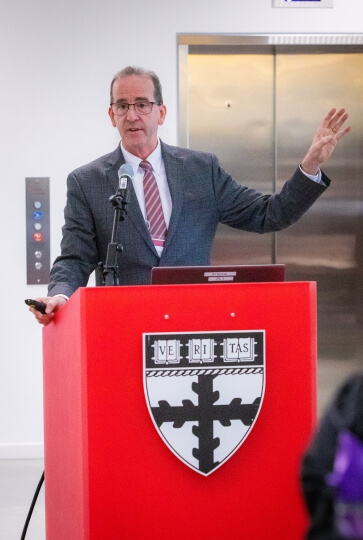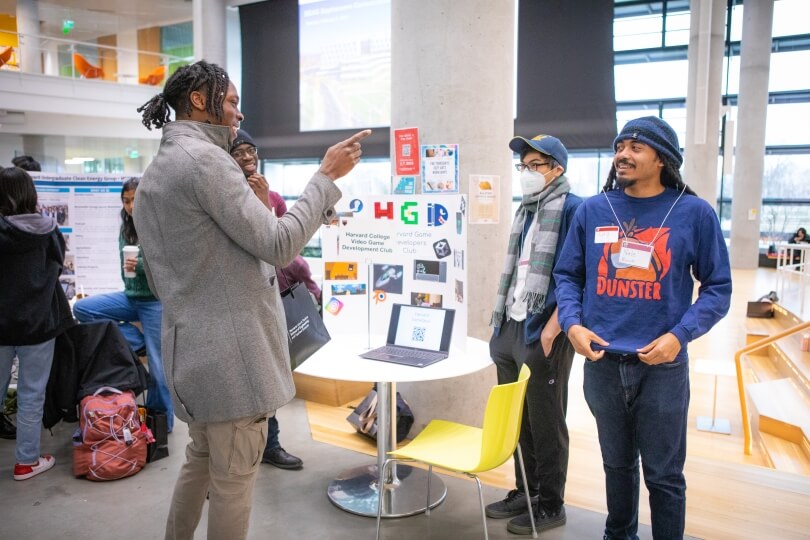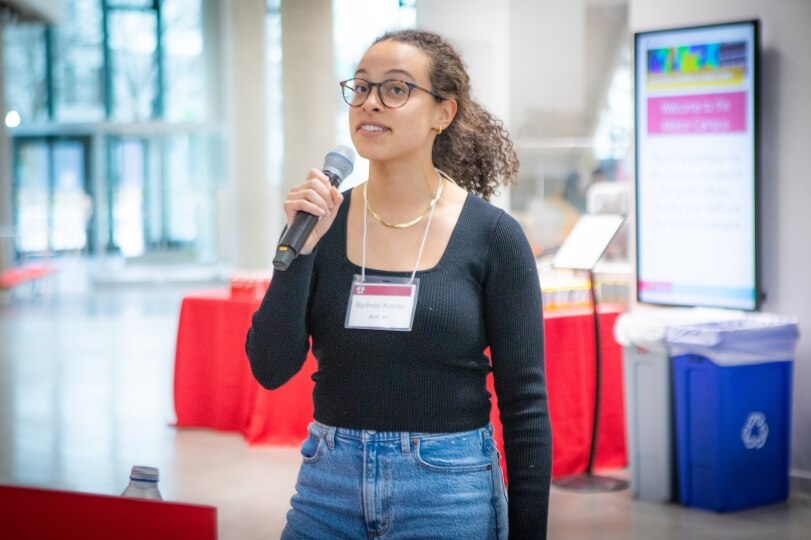News
SEAS Dean Frank Doyle addresses the Class of 2025 at Convocation at the Science and Engineering Complex. (Eliza Grinnell/SEAS)
Sanjna Kedia knew very little about the field of applied mathematics before arriving at Harvard. She came planning to study environmental engineering, but her introductory math classes shifted her academic interests.
“I’ve always loved and been interested in math,” she said. “The ability to study it on different tracks and the flexibility of applying math to computer science really interested me.”
Kedia is one of 502 sophomore concentrators welcomed to the Harvard John A. Paulson School of Engineering and Applied Sciences (SEAS) at Convocation 2023 at the Science and Engineering Complex. This is the largest sophomore class in the 15-year history of the school, and the SEAS student cohort now comprises 24 percent of the Harvard College student body.
“We’re a force,” said Dean Frank Doyle in his opening remarks. “If I were to take you back to when the school started 15 years ago, we were about 5 to 7 percent of the college. So, 24 percent is a long way that we’ve come.”
Approximately half of the Class of 2025 declared in computer science, followed by 30 percent in applied math and 20 percent in the various SEAS engineering concentrations. Tega Ajise came to Harvard already planning to study CS, but soon realized the field was so much larger than he’d ever thought.
“It’s been a good learning experience,” Ajise said. “I took ‘CS61: Systems Programming and Machine Organization’ last fall, which crystallized my thinking. It made me realize that one of the most important things about computer science is memory. Memory is what a lot of really big companies need to maintain their operations, and I want to explore that further in future courses.”
Chloe Hansen similarly arrived at Harvard knowing she wanted to study bioengineering. She took “ES53: Physiological Foundations for Bioengineering” earlier this fall, which confirmed it was the right field.
“Just meeting the people and Professor Linsey Moyer, I had a really good time,” Hansen said. “I always wanted to be premed, but I also loved math and physics. So bioengineering was a great compromise between the two for undergrad.”
Second-year student Tega Ajise, left, meets with the Harvard College Video Game Development Club at Convocation. (Eliza Grinnell/SEAS)
The Class of 2025 reflects the school’s ongoing efforts to promote diversity, inclusion and belonging. Of the 502 students, 38 percent identify as women, while 23 percent identify as underrepresented minorities – both better than national averages in engineering. Doyle’s remarks emphasized the important role of many of the affinity-based student groups at SEAS, including the Harvard Society of Women Engineers, Harvard Society of Hispanic Professional Engineers, and Harvard Society of Black Scientists and Engineers.
“We’re committed to making this an open and welcoming environment,” Doyle said. “There’s no better way to engage with the SEAS community than getting involved with clubs. Explore, find your passion, actively engage with your education both inside and outside out of the classroom and lab. The opportunities are almost limitless.”
Along with classes and clubs, SEAS also offers research opportunities through numerous laboratories across all its concentrations. In her one-minute lightning talk, fourth-year mechanical engineering student Megan Coram discussed her research in the Harvard Biodesign Lab led by Conor Walsh, Paul A. Maeder Professor of Engineering and Applied Sciences. Sydney Kepler, a fourth-year bioengineering student, discussed an internship designing pacemakers at Medtronic, then turning that into a research opportunity in the Chaikof Lab at Beth Israel Deaconess Medical Center.
Sydney Kepler addresses the Class of 2025 at Convocation at the Science and Engineering Complex. (Eliza Grinnell/SEAS)
“If I had to leave you with anything, it would probably be to get both a flavor of academia and research, and also industry opportunities,” Kepler said. “You all have so many resources to discover and explore both of those things, so I highly encourage you to do that.”
Doyle posed a series of “what if?” questions to the sophomores, all inspired by ongoing research at SEAS labs. They ranged from designing biocompatible lenses and computer screens for people with impaired vision, to predicting climate risks like wildfires and hurricanes, to creating sustainable and environmentally friendly technologies to power the metaverse. Each area of research reflects the SEAS mission the Class of 2025 will now continue: to discover, design, and create novel technologies and approaches to societal challenges in service to the world, the nation, and our community.
“You’ll have your own chance to explore questions like this through your studies, and hopefully through research interactions as well,” Doyle said. “I hope as you walk through our doors and see our mission on the wall, you too will embrace it and use it as a guidepost to help you think about your time here at SEAS.”
Topics: Academics, Active Learning Labs, Allston Campus, Belonging, Events, Student Organizations
Cutting-edge science delivered direct to your inbox.
Join the Harvard SEAS mailing list.
Press Contact
Matt Goisman | mgoisman@g.harvard.edu





